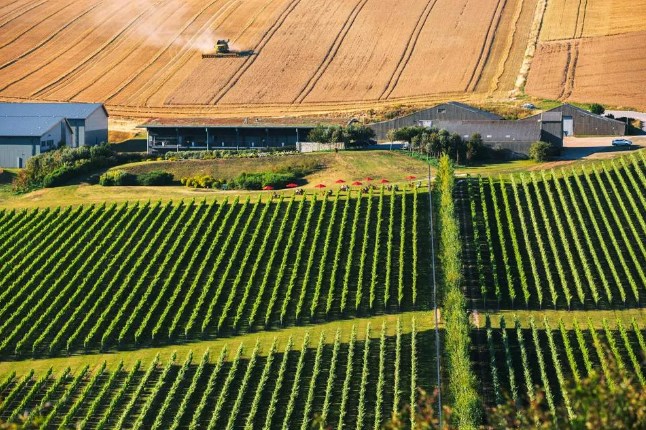
There’s nothing quite like sitting with a glass of sparkling wine, overlooking the rolling green hills, chalky grasslands, and windswept cliffs of the South Downs in Sussex, England. I recently enjoyed that view at the Rathfinny Wine Estate, one of the newest and largest wineries in England, while taking in the beauty of the Sussex landscape. Just a short trip from London, this sustainable winery is quickly becoming a major hub for English wine tourism.
In addition to learning about the winery’s sustainable practices to enhance the land and the wine, I talked with its founders, Mark and Sarah Driver, and the company’s vineyard manager, Cameron Roucher, about their plans for the company and how they incentivize community involvement. As a company, Rathfinny values collaboration, creativity, and diversity, and is committed to developing a local skilled workforce while supporting the English wine industry.
Established in 2010 and stretching across 600 acres of land, Rathfinny grows its vines in chalky soil that is geologically linked to the Champagne region of France, the world-renowned sparkling wine production region. This, plus a moderate climate and unique location, has made a huge impact on the rich flavors of their vintage sparkling wines. In the 10 years since purchasing this farmland, the Drivers have received recognition for the quality of their product and grown their estate into more than just a farm. It has become a restaurant, a manufacturing company, and a popular tourist destination. As they continue to expand, the Drivers stressed to me that they will always be mindful of how they build their business — whether it’s in how they farm their vines or how they treat their employees.
“We’ve always been very conscious as an employer,” Sarah says. “We wanted to bring people with us, and work collaboratively with our staff. Our mantra is that our staff are the most important asset we’ve got. We really want to carry people with us on this journey.”Building a Local Workforce
At the core of the Rathfinny Wine Estate is the importance of sustainable practices and their impact on the world as well as the community. One of the main ways the Drivers stay connected to their community is by hiring local residents whenever possible. As a company expected to receive its B Corp certification next month, they are legally required to consider their impact on workers, but the Drivers have always been inspired to stand out in their hiring practices. Rathfinny currently employs around 40 “core” people, and hires 200 or so additional seasonal employees.
Rathfinny works with a local recruitment company to find people seeking a flexible working schedule. For three to four weeks out of the year, the vineyards need to be pruned or picked. The people who take advantage of this opportunity come in all different walks of life — from needing extra money in and around their college courses to seeking a hobby outside their retirement. “They are our employees, and they’re regarded as part of the family,” Sarah says. “They range in age, which I adore, from literally 18-year-olds to men in their 70s. I’m immensely proud of that, even though it has been a cost to us.”Although the Drivers are passionate about their hiring practices, it would be misleading not to mention that hiring this way slows down productivity. On average, pruning 500 vines per day is the benchmark for a successful vineyard. Using local workers, Rathfinny now averages around 150 to 200 vines per day. “There are experienced crews that you can bring in, and we have occasionally used them whenever we were on a time restriction to get something done quickly,” Sarah says. “The local workforce can be slow, but they will get faster as the pool of experience grows. Plus some still need to be trained, and we have to use our best people to train them.”
Despite the challenges, the Drivers are proud of what they’re doing, and are already seeing results from their time investment. They have developed a group of local, loyal workers that they call “core casuals.” These are the people they turn to first whenever a working opportunity arises. This loyalty is an important part of the workplace the Drivers had always hoped to build.
“There is a huge amount of camaraderie,” Sarah says. “People enjoy coming here because they genuinely love what they’re doing, even if it’s standing in the beauty of the vineyard. I genuinely believe everyone feels invested in what they’re doing. They genuinely care and go the extra mile.”
Community Initiatives Aim to Support Local Tourism
Another way that Rathfinny has chosen to give back to its community is by investing in the future of English wines. The Drivers sponsored a new research lab in Plumpton, Sussex, back in 2014 at Plumpton College. The Rathfinny Research Winery was the first dedicated viticulture and oenology research center in England.
Critics sometimes question England’s place in the wine industry, but the truth is that sparkling wines from Sussex are regularly beating off Champagnes in international awards. Developing a strong research institution aims to back England as a credible and innovative wine-producing region, and to train the next generation of English viticulturists and wine makers.
While making its mark in a budding industry, the Drivers also strive to make Sussex, England, a major hub for wine tourism. Sussex is already well-known for its sweeping landscape, and as such established the South Downs National Park in 2010. The South Downs, also known as the “gateway to England,” stretches more than 600 miles and features dramatic chalk cliffs overlooking the English Chanel. Known as the Seven Sisters, cliffs attract legions of Asian tourists because the number 7 is considered lucky in China and a number of Chinese and Korean stars have been photoed there. The label on Rathfinnny wines includes an outline of the cliffs.
In addition, artists and winemakers have always been drawn to Sussex thanks to its inspiring and vine-friendly countryside. “We worked out that, actually, what attracted artists to this region was the landscape — the South Downs. And what attracted wine growers to this region was the unique geological features of the South Downs,” Mark says. “So we thought, ‘What a great synergy that exists between the art, wine, and landscape.’”
Rathfinny partnered with other Sussex vineyards and wineries, as well as art institutions around the area and the South Downs National Park, to create the Sussex Modern initiative. This collaboration brings together 36 destinations that all define the county’s modern, independent spirit. From other wineries in this burgeoning wine region to well-known art exhibits including the Bloomsbury Group’s Charleston House, Ditchling Museum, and Towner Gallery, Sussex Modern helps curate various experiences for tourists that all connect along southern England in Sussex. On their website, you can plot your visit to the South Downs — enjoy a wine tour, have some lunch, take in an art show, and go on a hike.
Located just an hour outside London, Rathfinny hopes that community efforts such as these will help grow Sussex into a global destination for tourists. Rathfinny already receives 40,000 visitors a year, and for the entire region the total is likely many times that. There is economic value for wine tourism: Domestic tourists who visit a wine region spend 40% more on average than a typical tourist; overseas tourists who visit a wine region spend 80% more.
Beyond the economic benefits, the Drivers hope to share the region’s natural beauty and opportunities with visitors.
“We want them down here,” Mark says. “We want them to share this beautiful landscape. We want to impress them. We want to show them what else they can do here.”
“People will often write and say how proud they are that this is in their community,” Sarah says. “They love visiting our vineyards. We have a lot of repeat visitors.”
